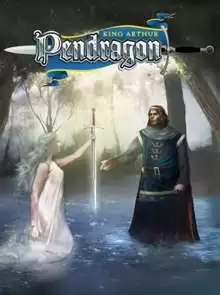King Arthur Pendragon Fantasy; Historical; Mythology and Folklore; Character Customization; Tactical Combat; Political
King Arthur Pendragon is a tabletop role-playing game renowned for its focus on chivalry, character traits, and generational play within the Arthurian legend. It distinguishes itself from other RPGs by emphasizing roleplaying over roll-playing, incorporating personality traits and passions that drive character actions, and allowing players to manage estates and play through generations of knights. The game targets players interested in Arthurian romance and character-driven narratives, offering a unique experience where virtue and vice shape the story and legacy of their knightly lineage.
Theme and Setting
Theme and Setting
King Arthur Pendragon immerses players in the world of Arthurian Britain, blending historical elements of 5th and 6th-century Britain with the chivalric romance of later medieval periods. The setting avoids typical fantasy RPG tropes, focusing instead on political, military, and spiritual adventures congruent with Arthurian legends. Players manage their estates, participate in tournaments, and experience courtly love, all while dealing with threats from Saxon invaders and internal conflicts. Adventures often span years, even generations, as players take on the roles of their character's descendants, building a family legacy within the Arthurian world. The core setting is a mix of sub-Roman Britain with feudal elements projected backward. While the default is this pastiche, campaigns can also be set in a more historically accurate Dark Ages or a more fantastical Arthurian Britain.
Core Mechanics and Rules
Core Mechanics and Rules
The game mechanics revolve around a variant of the Basic Role-Playing (BRP) system, using a d20 for skill resolution rather than a d100. A key feature is the use of Traits and Passions to define character behavior. Traits are opposing values (e.g., Chaste/Lustful, Valorous/Cowardly) that represent a character's personality, influencing decisions and roleplaying. Passions are strong emotions (e.g., Love, Loyalty, Hate) that can inspire characters to great feats but also lead to despair or madness if violated.
Players roll a d20 to use a Virtue or resist a Vice, succeeding if the roll is at or below the value. Traits and Passions guide gameplay and create internal conflict, such as a loyal knight facing an unjust order. Combat is resolved using an opposed resolution mechanic, and the game includes systems for mass combat, skills, and managing family affairs between adventures. The emphasis is on character development and roleplaying decisions driven by these traits and passions, rather than purely tactical combat encounters.
What Makes it Unique
What Makes It Unique
King Arthur Pendragon distinguishes itself through its emphasis on generational play, allowing players to experience a character's life, marriage, aging, and legacy through their descendants. The game's focus on chivalric virtues and vices, as represented by Traits and Passions, drives character actions and creates meaningful roleplaying opportunities. The game uniquely blends historical and romantic elements, creating a world that feels both authentic and fantastical. Unlike many RPGs, Pendragon prioritizes character development and moral choices over dungeon crawling and combat, creating a narrative-rich experience where the players' decisions shape the fate of their characters and their families within the Arthurian world. The integration of seasonal adventures further enhances this unique experience.
Target Audience and Player Experience
Target Audience and Player Experience
King Arthur Pendragon targets players interested in Arthurian legends, character-driven narratives, and moral roleplaying. The game offers a unique experience where players embody knights striving for glory while adhering to a chivalric code. The generational aspect allows for long-term campaigns and the development of family legacies, creating a deeper connection to the game world. Players should enjoy exploring the complexities of virtue and vice, making difficult choices, and experiencing the consequences of their actions on both personal and societal levels. A successful Pendragon campaign requires players willing to embrace the roleplaying aspects and immerse themselves in the Arthurian setting, appreciating the blend of historical and romantic elements that define the game's unique appeal.



